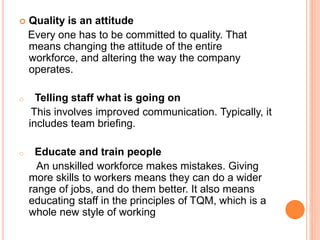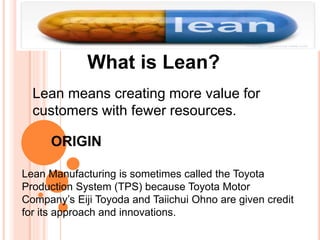Kaizen, TQM, Lean
- 2. WHAT IS TOTAL QUALITY MANAGEMENT ? TQM is an approach to improving the effectiveness and flexibilities of business as a whole. It is essentially a way of organizing and involving the whole organization, every department, every activity and every single person at every level. TQM ensures that the management adopts a strategic overview of the quality and focuses on prevention rather than inspection.
- 3. OBJECTIVES OF TQM Meeting the customers requirements is the primary objective and the key to organizational survival and growth. The second objective of TQM is continuous improvement of quality. The management should stimulate the employees in becoming increasingly competent and creative Third, TQM aims at developing the relationship of openness and trust among the employees at all levels in the organisation.
- 4. SIGNIFICANCE OF TQM The importance of TQM lies in the fact that it encourages innovation, makes the organization adaptable to change, motivates people for better quality, and integrates the business arising out of a common purpose and all these provide the organization with a valuable and distinctive competitive edge.
- 5. ELEMENTS OF TQM Be customer focused It requires the company to check customers attitudes regularly and includes the idea of internal customers as well as external ones. o Do it right the first time This means avoiding rework, i.e., cutting the amount of defective work. o Constantly improve Continuous improvement allows the company gradually to get better.
- 6. Quality is an attitude Every one has to be committed to quality. That means changing the attitude of the entire workforce, and altering the way the company operates. o Telling staff what is going on This involves improved communication. Typically, it includes team briefing. o Educate and train people An unskilled workforce makes mistakes. Giving more skills to workers means they can do a wider range of jobs, and do them better. It also means educating staff in the principles of TQM, which is a whole new style of working
- 7. REASONS FOR FAILURE TQM fails because Top management sees no reason for change. Top management is not concerned for its staff. The workforce and the management do not agree on what needs to happen. Urgent problems intervene. TQM is imposed on the workforce, which does not inwardly accept it. No performance measure or targets are set, so progress cannot be measured. Processes are not analyzed, systems are weak and procedures are not written down.
- 8. Masaaki Imai is known as the developer of KAIZEN. ‘KAI’ means ‘Change or the action to correct’. ‘ZEN’ means ‘Good’. Kaizen is small incremental changes made for improving productivity and minimizing wastes.
- 9. 3 MAIN PRINCIPLES OF KAIZEN 1. Consider the process and the results. 2. The need to look at the entire process of the job at hand and to evaluate the job as to the best way to get the job done. 3. Kaizen must be approached in such a way that no one is blamed and that best process is put into place.
- 10. FEATURES OF KAIZEN Widely applicable. Highly effective and result oriented. A learning experience. Team based and cross-functional.
- 11. PHASES IN KAIZEN A. Select an event B. Plan an event. C. Implement an event. D. Follow-up an event.
- 12. BENEFITS OF KAIZEN Kaizen reduces waste - like inventory waste, time waste and workers motion. Kaizen improves space utilization and product quality. Results in higher employee moral and job satisfaction. Teaches workers how to solve everyday problems.
- 13. What is Lean? Lean means creating more value for customers with fewer resources. ORIGIN Lean Manufacturing is sometimes called the Toyota Production System (TPS) because Toyota Motor Company’s Eiji Toyoda and Taiichui Ohno are given credit for its approach and innovations.
- 14. SEVEN PRINCIPLES OF LEAN 1. Over-Production 2. Waiting 3. Transportation 4. Inventory 5. Motion 6. Over-processing 7. Defective units
- 15. , 1. Over Production – Producing over customer requirements, producing unnecessary materials / products. 2. Waiting – Time delays, idle time (time during which value is not added to the product). 3. Transportation – Multiple handling, delay in materials handling, unnecessary handling. 4. Inventory – Holding or purchasing unnecessary raw materials, work in process, and finished goods.
- 16. 5. Motion – Actions of people or equipment that do not add value to the product. Over-processing – Unnecessary steps or work elements / procedures (non added value work). 7. Defective units – Production of a part that is scrapped or requires rework.
- 17. CONCEPT USED IN LEAN JIT (just in time):- It means producing the necessary items in necessary quantities at the necessary time. Benefits of JIT: 1. Reduced operating cost 2. Greater performance 3. Higher quality 4. Improved delivery 5. Increased flexibility and innovativeness 6. Shortened lead time 7. Reduced inventory
- 18. . “ The most dangerous kind of waste is the waste we do not recognize." ~ Shigeo Shingo
- 19. Prepared by:- Bhavya Sharma Shivi Srivastav Saurabh Negi



















